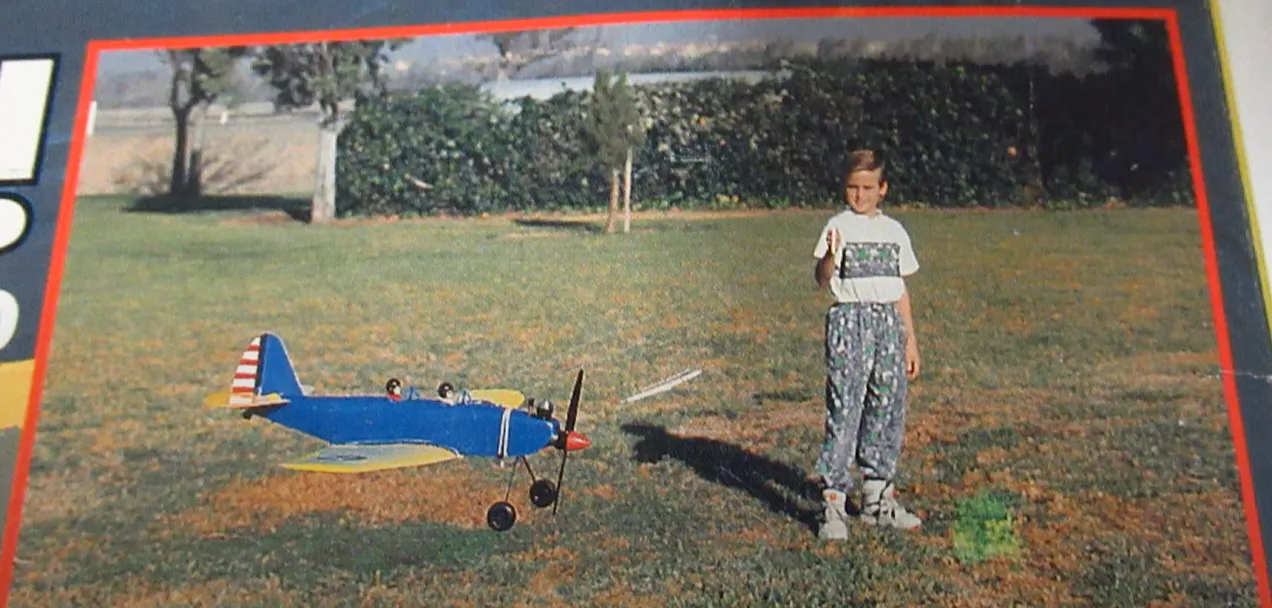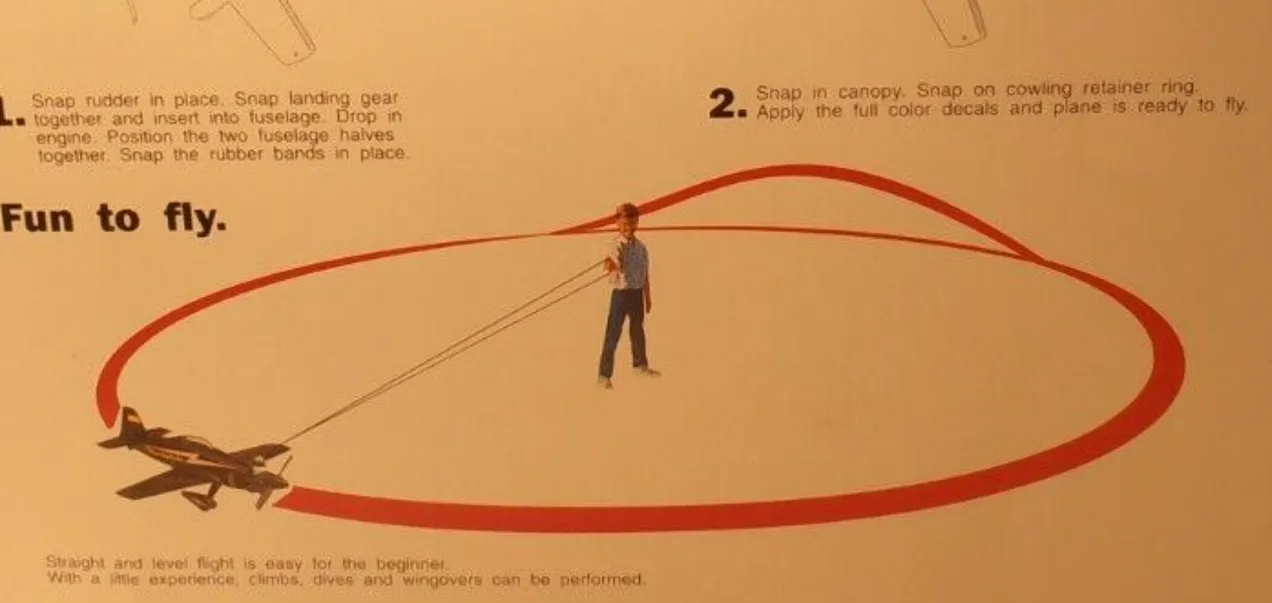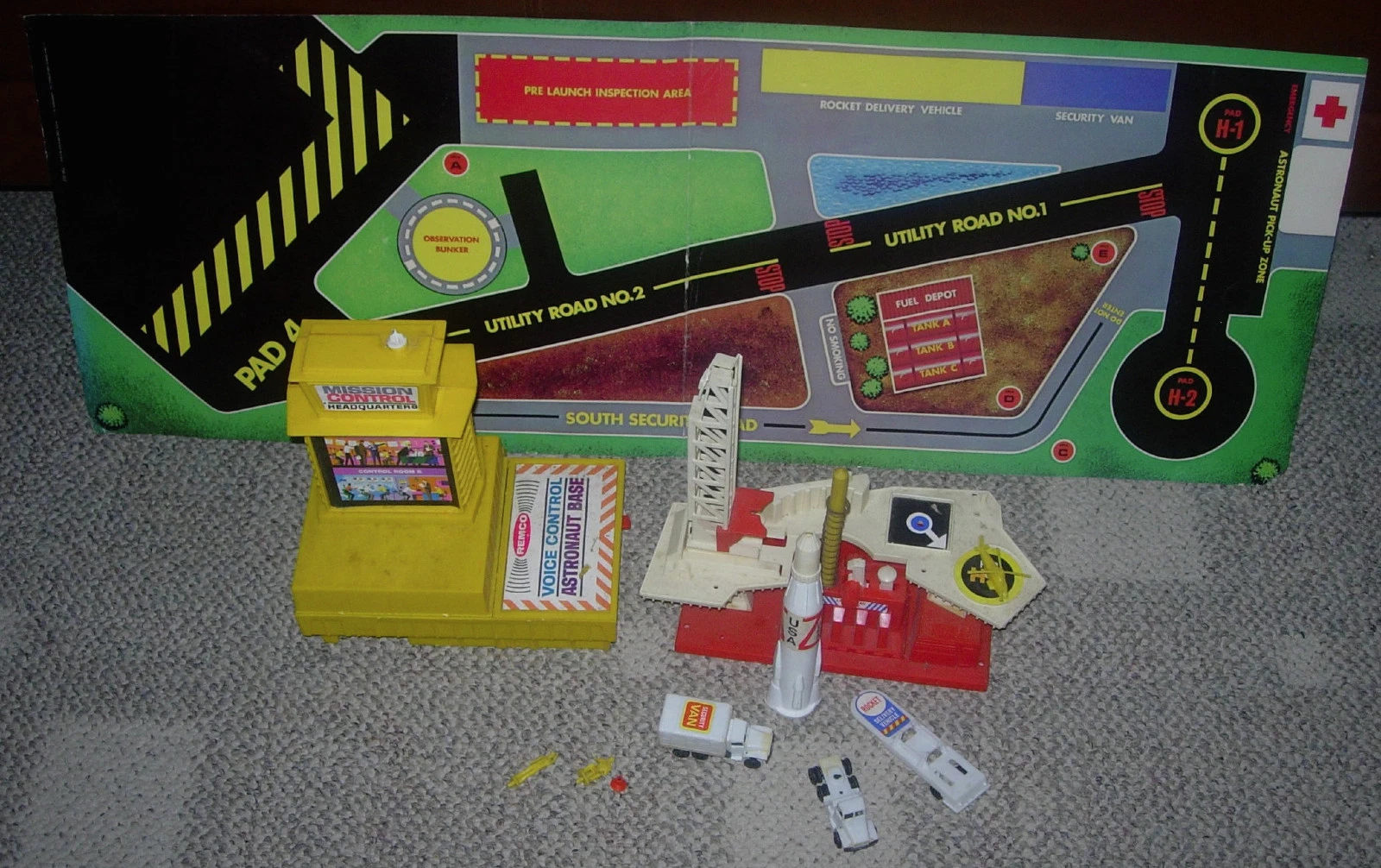
Posted on 07/24/2025 7:51:23 AM PDT by Red Badger

Mark here. It’s hard to exaggerate the allure of the Cox E-Z Flyer. To a young boy in the late 1970s, the Cox E-Z Flyer was the best toy in the world. It was also loud, dangerous, and doomed.
Why Is This Interesting?
The Cox E-Z Flyer was a control-line model airplane powered by a tiny internal combustion engine. It was attached to two 50’ control lines that ran to a handle. The model airplane enthusiast would hold the handle as the plane spun in a 100’ diameter circle around the pilot until it ran out of fuel or crashed. These two outcomes were equally likely.
Theoretically, the control lines allowed the pilot to perform tricks and maneuvers with the plane by tilting the handle to manipulate the plane’s control surfaces. However, as a practical matter for most Cox EZ-Flyer owners, this illusion of control only served as a temptation to stray from the only prudent flight plan, which was level flight until fuel exhaustion.
Did the pilot get dizzy? Yes.
Could a passerby get snared in the spinning control line such that the plane circled closer and closer on an ever-tightening death spiral until the whirling propeller and the incandescently hot metal engine collided with its victim? Theoretically, I guess. But it seems more likely that the plane would lose vertical control and crash long before this, leaving the pilot and the victim to explore concepts such as fault, responsibility, and liability.
Because the Cox E-Z Flyer began its inexorable motion immediately upon starting, it required two people to operate: the pilot and someone to start the plane. Starting a Cox E-Z Flyer had its own challenges and dangers. The starter would hand-crank the tiny, sharp propeller like an old-time barnstormer. A small spring hooked around the propeller. The starter would spin the propeller backward against the spring, then flick it to release the prop, hoping the engine would kick into life. Frequent mis-starts encouraged the starter to ever more enthusiastic prop-flicking, which increased the chances that when the tiny engine burst into life, the starter’s fingers would be in the path of the propeller. Typing this paragraph vividly evokes the sting of a fresh cut on gasoline-soaked fingers.
Starter/crowd control was this writer’s assigned serfdom—since the Cox E-Z Flyer that came (briefly) into our house was the property of my eleven-year-old brother. At age nine, all I got to do was struggle to start the plane and then hold back the curious neighbors, dogs, and occasional motor vehicle traffic as my brother spun his orbits around our cul-de-sac.
My crowd control efforts were made easier by the shockingly loud buzz emitted by the tiny 0.049 cubic inch two-stroke engine. These adorable powerplants are called “glow plug” engines because the fuel is ignited by the glowingly hot engine itself. In the unlikely event of a successful flight, the enthusiastic pilot would no doubt want to fly again immediately, leaving the starter to try to refuel and re-prop an engine that was literally hot enough to ignite its own fuel. A precise blend of fuel and lubricant was required, both helpfully sold and supplied by the Cox Model Engine Company.

Cox 0.049 cubic inch glow plug engine
One day, after my brother had pulled off another flawless full-tank-to-exhaustion rotating flight on our cul-de-sac, I managed to wheedle and whine enough to get him to allow me to fly his plane. Our very poor idea was for him to begin the flight (I’d prop and start the plane as usual), then I’d dash to the center of the 50’ radius, grab the control handle from him, and continue the flight. This did not go as planned. The moment of slack created when we handed off the controls sent the plane into a climb, then an unrecoverable dive. The little plane crashed into the pavement and burst into dozens of pieces of sharp plastic and hot metal. My relationship with my brother suffered similarly irreparable damage.
Control line model aviation is a rich and rewarding hobby pursued with great skill and care by enthusiasts all around the world. The Cox E-Z Flyer may have been an excellent model for the hobbyist, but as a toy for children, it was terrible, sure to end its short service life in tears and flame. You may be thinking that the Cox E-Z Flyer was never intended for children and that it only fell into the hands of kids who adroitly manipulated their parents into buying them a gift intended for adults. But no, dear reader. Take a look at this:

This is the back of the box for the Cox E-Z Flyer. How old is that hobbyist? Nine?
The Cox Hobbies company merged with the equally exciting Estes Model Rockets in 1996, but competition from inexpensive electric-powered, radio-controlled aircraft spelled the end of production soon thereafter. Dedicated fans of Cox’s tiny internal combustion engines keep a market alive for parts and fuel, and Cox E-Z Flyers are available from time to time on eBay. Serviceable models can be found for about $200. (MJS)
Quick Links: (AT SITE)
This introductory video for control-line flying, “Wired for Excitement”, is narrated by the great John Facenda of NFL Films fame. (MJS)
Brodak.com covers all things related to control-line flying (MJS)
The Wikipedia page for the Cox model engine (MJS)
First flight video of a New-In-Box Cox E-Z Flyer of the same type and model that I famously crashed. “They don’t make educational toys like this anymore”- Educational? (MJS)
Thanks for reading,
Noah (NRB) & Colin (CJN) & Mark (MJS)
==============================================================
Mark Slavonia (MJS) is an investor, a pilot, and an avid cyclist. He wrote about radio altimeters, rowing machines, traveler’s checks, and more. He posts other things that are interesting on his website.
=============================================================
We had a lot of airplanes. From my early days in the 60s with a Piper Cherokee and a tri-wing my Uncle gave us that were control line with rather large engines to stick built free flight models with Gasparin CO2 engines, elegant little things those are. Then there was the RC trainer Dad built for my son. In the test flight it went up spectacularly and came down the same way bursting into matchsticks. Shortly after that he graduated to the Cessna 150 and did his cross-country flights starting at 14; he moved on to fly the venerable T-38 and F-15E and is coming up on retirement.
Prop sticks save fingers.
My father got me one for Xmas, a P-51.
- , =
F4-U Corsair here - my Dad was a Korean conflict vet. We even had a big open field to fly it on two minutes walk from the house.

When I was growing up, my best friend up the street had
a Stuka dive bomber. I don’t recall what happened to it,
but he was certainly bitten by the aviation bug; he became an airline pilot.
That cox was LOUD! Loved flying it though.
I saved my chore money and was incredibly excited to buy a Cox plane. Baa Baa Blacksheep was my favorite TV show so it was to be their Corsair model.
I don’t remember if it made more than two or three rotations before it plummeted into the ground and snapped off one of the gull wings. There was no repairing the damage nor replacement parts available from Cox. It was literally less than a minute of fun!! I ultimately threw the plane away and used the leftover fuel in an irresponsible manner.
” It was literally less than a minute of fun!! “
LOL! I was watching my father. I got a few seconds of thrill as I started the engine and it took off.
Followed by a second of terror as ot looped back in my direction.
I had one. The wings were held on with rubber bands, so the inevitable crash wasn’t too destructive. Found the wrong end of it more than once, but it wasn’t that bad.
Fun times.
I started with the PT 19 and a Stuka and then P40.ended up rebuilding real P40s for almost 30 years.very fond memories.
Glo-fuel
Fun reminiscence, but “gasoline”???
The author never fueled a Cox 0.049! I used special Glo-Plug fuel that burned and lubricated the engine.
“Cox .049 engines, also known as 1/2A engines, typically use a special glow fuel mix. This mix usually consists of methanol, castor oil, and sometimes nitromethane. The exact proportions can vary, but a common recommendation is around 20% castor oil and 10-40% nitromethane, with the remaining portion being methanol.”
We used to fly combat where you tried to cut the streamer off the other plane.what a nightmare that was and then we would try to cut the control lines off of each others planes sometimes resulting in midair crashes which were spectacular.
Boy, did I have a flashback!
Long walk home with the pieces...
I had one with my brother. Lots of fun, and lots of crashes. We also had a Stuka, but that broke apart early on.
Ah, yes. Another brilliant product from Mainway.
I think it was a nitro methane mix. Funny car fuel.
I had one of these...for about 30 seconds!
I had a Cox P-51 that flew exactly twice before I crashed it.
Then I moved on for Estes rockets.
I’m pretty sure I sent one into low earth orbit once. I managed to jam a D sized engine into a rocket made for A engines. It took a bit of modification but I actually got it to launch.
Lost sight of it somewhere over Summit County OH heading north towards Lake Erie.
Don’t get me started on the chemistry set my grandfather bought for me. I’m sure the EPA would send a SWAT team to get it today.
L
Disclaimer: Opinions posted on Free Republic are those of the individual posters and do not necessarily represent the opinion of Free Republic or its management. All materials posted herein are protected by copyright law and the exemption for fair use of copyrighted works.